Honda BR-V is the Mexican SUV You Didn’t Know About
Honda dealers in the U.S. want more SUVs, and we suspect Canadian dealers are thinking the same thing. Apparently, the HR-V, CR-V, Passport and Pilot are not enough.
In late 2023, a new electric SUV will join the Honda lineup (with the help of GM), but in the meantime no addition is planned. What about the Honda BR-V?
- Also: 2020 Honda CR-V: 10 Things We Like or Dislike
- Also: Honda, Acura Dealers Want More SUVs; Will They Get Them?
Launched in 2016 and initially intended for Asia-Pacific countries, this model landed in Mexico alongside the HR-V, CR-V and Pilot (the Passport is not sold down there). Of course, it’s not the type of product that could meet the needs of customers up north, including us here in Canada, but the last time we checked Mexico was still part of North America.

Standing 4.45 metres long, the BR-V slots between the HR-V and CR-V. At just over 2,700 pounds, it’s actually lighter than the former, while the exterior design is more similar to that of the latter, especially up front. The beltline on the sides is somewhat reminiscent of the Odyssey minivan, as well.
With body cladding around the wheel arches, a large greenhouse and raised roof rails, the Honda BR-V clearly puts a focus on utility. And believe it or not, there’s three-row seating inside. As you can imagine, the poor souls sitting in the back must feel pretty squeezed.

As for the engine, a 1.5-litre four-cylinder endows the BR-V with a modest 118 horsepower—23 fewer horsepower than the 1.8-litre mill in the HR-V. No turbo is included, so peak torque is even less impressive at 107 pound-feet. That’s awfully weak for a seven-passenger SUV. And forget about towing or off-road driving.
The 2021 Honda BR-V starts at 347,900 MXN, which would reprensent a base price of just over $21,000 in Canada. We’re definitely more excited about the upcoming 2022 Honda HR-V.











